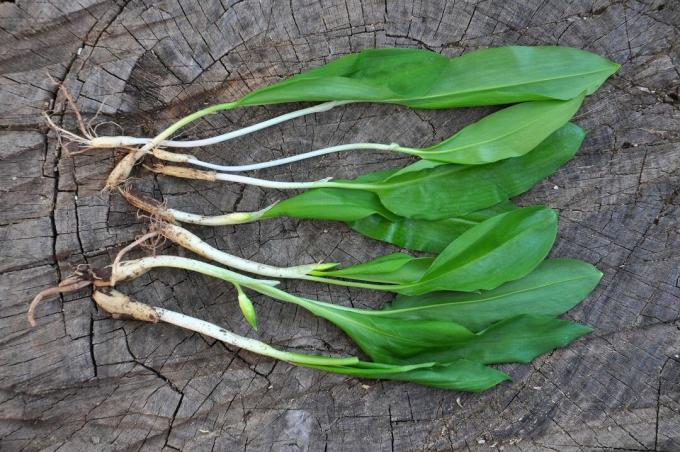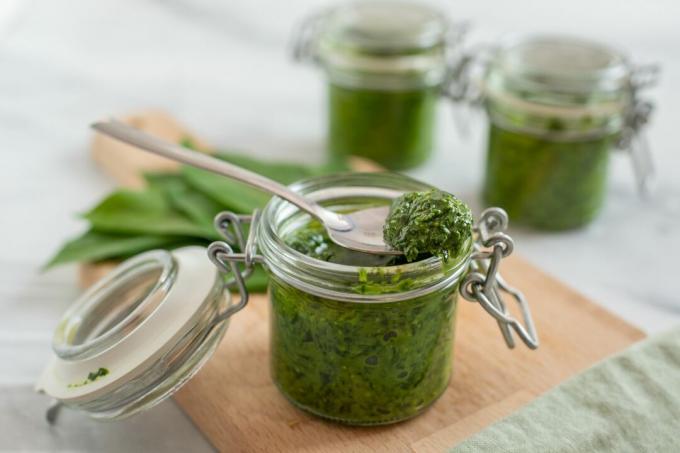Wild garlic is not only very healthy, but also very tasty. Here we show tips and tricks for growing in your own garden as well as the best recipes.

Where does the term wild garlic (Allium ursinum), also known in English as bear’s garlic, is still a mystery to this day. For the Germans wild garlic was a medicinal plant, which they attributed to the powers of a bear. Others suspect the origin of the name in the fact that many a starved master Petz ate wild garlic greens during a long and barren winter to satisfy his hunger breastfeed. Even if the origin of the name remains unclear, we know that wild garlic is closely related to garlic, leeks and onions. The flavor-intensive herb grows in many parts of Europe and occasionally in the forests of Asia and North America. Due to its special aroma, wild garlic, which sprout in spring, is a popular prey for walkers in the forest and is often collected.
contents
- Cultivation: seeds or bulbs
- Harvest and preserve wild garlic
- Ingredients and use in the kitchen
- Our tips for wild garlic recipes
The plant grows about 20-30 cm high. At the beginning, the leaves are still slightly light green in color. Later in summer they are significantly larger, somewhat more fibrous and dark green. At 2-3 cm, wild garlic bulbs are significantly smaller than vegetable onions or the bulbs of the related garlic.
While fresh wild garlic usually costs a fortune at weekly markets and delicatessens, you can easily grow the delicious leafy vegetable in your own garden.
Synonyms: bear's garlic, wild garlic, wild garlic, ramsen, bear's garlic (engl.), ramsons (engl.), wild garlic (engl.)
Cultivation: seeds or bulbs
Wild garlic is mainly found in (Au) forests and it is hardly surprising that the plant prefers a partially shaded location. The soil should be humus, nutritious and slightly moist.
The delicious wild garlic can be propagated in two ways. You either sow the seeds or you go straight to the bulbs. The seeds need frost to germinate, because wild garlic is a classic cold germinator. Therefore, the seeds are either stratified in advance or sown directly into the bed in autumn. The sowing depth is two to three centimeters. It can be planted quite densely - three to five centimeters apart is enough. However, better results are obtained with onions. These are inserted about four to five centimeters deep. In the right location, the onion usually develops into a strong plant in the first year. Harvesting can begin in the second year of location. If you want to harvest even faster, you can also buy wild garlic as a potted plant.

Wild garlic is a very grateful herb and only needs to be watered and fertilized sparingly. Before planting, it is best to provide good soil that can also retain moisture for some time. Poor soils are replaced with a more nutrient-rich soil like our peat-free Plantura Organic universal soil or alternatively enriched compost. In our latitudes, watering can be safely dispensed with. Exceptions, however, are very sunny locations with dry soil. In summer, when the temperatures rise and the soil is occasionally dry, the wild garlic moves in anyway.
A detailed step-by-step guide to cultivation can be found here: Plant wild garlic: Plant wild garlic yourself.
Harvest and preserve wild garlic
The herb can be harvested continuously between March and June. It is best to harvest the outer leaves first, because then the inner leaf pairs will follow faster. But be careful: If lilies of the valley are in your own garden, there is a risk of confusion. Children should also be warned about this. However, the garlic-like smell is an easy and useful distinguishing feature, which is why nothing stands in the way of safe consumption. The herb should be processed fresh because, like basil, for example, wild garlic loses its aroma when it dries. You can also freeze it well or pickle it with plenty of oil (pesto). The greens can be stored in the fridge or in a cool cellar for a few days when they are still moist.

Ingredients and use in the kitchen
Many appreciate the good properties and ingredients of wild garlic. This is also likely to have triggered the wild garlic trend over the past decade. While many properties come from outdated medical science or are pure superstition, the antibacterial effect has now been medically confirmed. Fresh wild garlic, as a salad or pesto, is said to relieve coughs and fevers in particular. In addition to vitamin C and minerals such as iron and magnesium, alliin and allicin are included. The latter is responsible for the typical smell of garlic and is considered a pharmacologically active substance. In some pharmacies you can now obtain a tincture made from the trend vegetable. According to advertising, several properties are attributed to it: relieves cough and fever, lowers blood pressure and cholesterol levels and promotes the heart. In our opinion, wild garlic is best enjoyed fresh from your own garden. That's the only way to know exactly what you're eating. Worth knowing: Contrary to popular belief, the onions can also be eaten.
Our tips for wild garlic recipes
Wild garlic pesto: Here the wild garlic should be finely chopped and mixed with pine nuts, walnuts or almonds and plenty of grated Parmesan. The porridge is seasoned with good olive oil and a little salt, for example. Once poured into a suitable jar, the pesto must be covered with oil. Otherwise it will quickly start to mold.

Wild garlic bread: You can either mix the bread dough yourself or you can use a bread baking mix. These can often be found in well-stocked grocery stores. Finely chopped, fresh wild garlic is added to this. If you add some butter or oil to the dough, the aroma of the wild garlic comes into its own.
Wild garlic pizza: The use of wild garlic on a pizza is particularly tasty. Here you can either briefly fry chopped, fresh wild garlic and use it to top the pizza, or you can use a wild garlic pesto. If a pure wild garlic topping is too much for you, spinach (and possibly Mix in the ricotta.
Wild garlic as an herb for refining meat and fish dishes: Similar to garlic, wild garlic is an ideal accompaniment to meat and fish. The finely chopped wild garlic should only be added fresh before the end of cooking or immediately.



